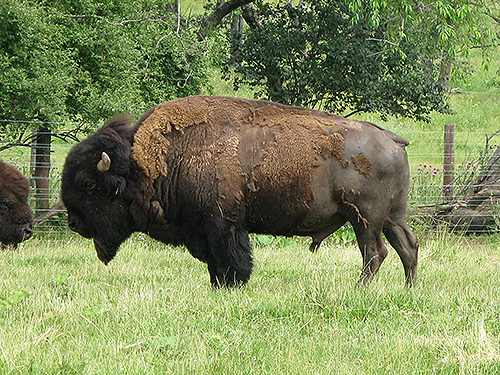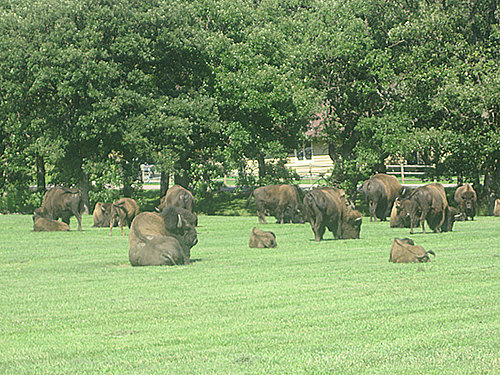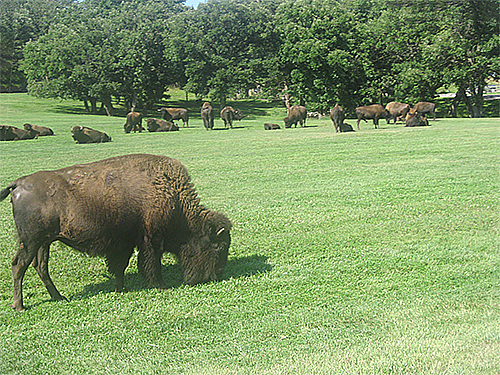
Fact Sheet FS945
Introduction
There are three subspecies of bison (American buffalo) that exist today; Bison bison bison, or plains bison are found on the plains of North America, Bison bison athabascae, or wood bison are found in north central Canada, and Bison bison bonasus, the only European species.(4) The European species is also called the wisent and is approaching extinction, with only a few animals remaining in parks and zoos. All three species are descendants of Bison bison occidentalis from Siberia.(1,10)
Though bison and buffalo are sometimes used to refer to the same animal, they are two separate species. Bison are characterized by a large hump on the back and 14 pairs of ribs and are found in North America. They have large heads covered in thick brown or black fur for cold climates. Buffalo are found in Asia and Africa, possess no hump, and have 13 pairs of ribs. They have smaller "cowlike" heads and thinner fur meant for warmer conditions. Buffalo usually refers to the African cape buffalo or the Asian water buffalo. The term buffalo was also given to bison during the settlement of North America and is often used interchangeably with bison. Bison is used more popularly in science while buffalo is used in cultural relations.(1)
Background
It is believed that bison entered North America more than 200,000 years ago and were followed by Asian hunting tribes that crossed into Alaska via the ancient land bridge. At their peak populations, they numbered 30–70 million and roamed over nearly half of North America. The indigenous people of the plains had a tight-knit relationship with the bison and relied on them for many things. Indigenous people hunted these animals in many creative ways. Sometimes by circling them on foot and shooting arrows, stampeding an entire herd over cliffs, or driving them into a natural trap. With the introduction of the horse during the mid-1600s, it was easier for the Native Americans to employ earlier hunting methods which enabled them to hunt during the winter months more easily.(9)
The Indigenous people of the plains were very grateful for the bison's lives they took as it allowed them to live. They used every part of the animal to ensure its life was worth taking and nothing was wasted. Bones were used as tools to game dice, rawhides were used for shields, shoes, and saddles, fur was used for clothing blankets, and stuffing, and fat was used for grease, heat, and medicine. Every part of the bison that could be consumed was, the tongue being seen as a delicacy. They also used the "buffalo" for many spiritual rituals as they relied on them for many things. The "buffalo dance" was used when the hunters could not find any "buffalo" and lasted until they brought back enough. Native American lore said that the birth of a white bison signified the beginning of an epoch of peace and reconciliation among all people.(3)
Mass slaughter of bison by settlers occurred from 1840 to 1880. Bison were killed because they would stop trains as they crossed the prairies and settlers wanted their hides or tongues. The slaughter was also used as a tactic to control the natives as they relied on the animals so heavily that without them, they could not survive. After the slaughter, the remaining carcasses were left on the plains to rot. In the mid-1800s there were an estimated 60 million bison in North America, but by 1883, bison were close to extinction. By 1900, it was reported that there were less than 100 of these animals in the wild. During the beginning of the slaughtering, some mid-western ranchers took in young bison calves, cared for them and bred them. Later, once laws were passed to protect the bison population, some of these bison were sent to start the herds in National Parks such as Yellowstone.(13)
Bison are the largest land animal and game species that are hunted in North America.(9) A bison's eyes are adapted for 360-degree vision and farsightedness making their vision extremely poor. They often rely on smell and hearing at close range. The average life span of wild bison is 12 to 15 years, but they have been known to live up to 40 years in captivity. Present-day natural predators include wolves, and severe winter weather can also limit bison activity killing a lot of the young and elderly.
Management
Bulls stand six feet tall and ten feet long, with the average animal weighing one ton. Bulls can breed beginning at two years and reach full maturity at five years. Cows are smaller, standing 5 feet tall and weighing 700 to 900 pounds. Breeding takes place from mid-July through the end of August, and the calving season is late April through mid-May. Artificial insemination is not successful and suggested natural breeding ratios are one mature bull to 15 cows. Breeding bulls should be replaced every two years to prevent inbreeding.(9) The reproductive life for both sexes is 12 to 20 years. Gestation is 9 ½ months, and a cow usually calves for the first time at three years of age.(11)
Cows give birth to a single, 30 to 70-pound, rust-colored calf. The rust-colored coat remains bright for 3 months before changing to brown. Calves can stand upright within 30 minutes to one hour of birth and they graze within a week. The calves are weaned around six months of age. Bison are identified by tagging. Dehorning is recommended if one is handling the bison. The optimum time to do this is at six weeks of age and should be done before the fly season or after a killing frost. Castration is not a routine practice because bulls are sold for meat before the breeding age is reached and before meat flavor is affected.(9)
In an orphan calf, colostrum should be offered during the first few hours of life. Dairy cow colostrum is adequate and more available than bison colostrum. Acceptable types of milk replacers are goat's milk, evaporated milk, and water, or sheep's milk. The feeding recommendation for a milk replacer is ½ to 1 pint, 4 to 6 times a day for two weeks. After two weeks, the amount offered could be increased to 1½ to 2 quarts twice daily. Though most milk replacers work, sheep's milk is the most similar and works the best. Scours should be watched for. By 3–4 months the calf can be weaned and should be on a decent quality diet of feed.(7,9)
A bison is a ruminant whose diet may consist mainly of grasses and other forages. Bison are usually raised on pasture, seldom in feedlots. They normally move while grazing and have been noted to cover a ¼ to 3-mile area. The recommended protein level is 11 to 13%, and mineral requirements are like cattle.(9) Most minerals are supplied in forages, and little supplementation is necessary. In the wild, females usually lead the herd because they have a better memory of seasonal patterns of grass availability and the location of water sources.(6) During periods of harsh weather, bison can locate grass under a layer of snow using their large heads and can eat the snow to meet their water requirement.(9) If necessary, bison can go several days without water.
Handling Bison management techniques have evolved from those practiced by cattle ranchers. Bison are not domestic animals and require particular care when handling. They respond best to slow and quiet movements. They are more excitable in close quarters, so fences around handling areas must be taller and stronger than those around pastures. When handling bison, use a chute with a squeeze gate. It is suggested not to disturb pregnant cows in the spring due to possible injury, abortion, or premature birth. Cows may be vicious and protective if their calves are threatened. It is also recommended that bulls not be worked with during breeding season for safety concerns. Bison prefer the natural shelter of shrubs and rough terrain to those of artificial construction. Confinement areas for bison should include large, open, green pastures with fresh water available. Fences should be constructed of heavy-duty, woven wire supported by wooden posts, 6 feet in height.(14) Barbed wire is not recommended.
Several factors including types of forage, soil, and water quality are dependent on the number of bison that may be raised in a particular area. It is suggested that 1 acre of land per animal is provided, equivalent to that required for cattle.(9) When introducing new animals into a herd, isolate them first for 2 to 4 weeks to monitor the animals' health and then slowly introduce them into the herd.(5)
Getting Started
When starting a herd, purchase calves as a foundation before buying mature animals. Young animals may adapt more quickly to new environments than older animals.
Regarding the consideration of the purchase of animals, there are some traits to look for: large, lengthy, well-developed hindquarters, and good conformation as exhibited by flat backs that slope toward the tail. Additionally, it is desirable to have a large body frame with adequate width and depth over length.(9)
There are several possibilities when raising bison: absentee ownership, hobby ownership, small producer set-ups, medium-size ranches, and large ranches. Absentee ownership involves a contract between an owner and an existing ranch to own one or more animals. This option offers investment and tax shelter opportunities, but due to rising costs and other problems, this is not a popular practice. Hobby ownership refers to housing a few bison, usually less than 25 animals, that are used as tourist attractions or as part of a display. A small producer is someone with a herd numbering 25 to 100 animals. This type of ownership sells breeding stock and extra bulls for meat animals. A medium ranch is an operation like a small producer but raises a greater number of animals. Bison is the major source of income for a large ranching operation. In addition to raising breeding animals and selling excess bulls for meat, they may also have a working feedlot.(9)
Uses
Bison are raised primarily for meat. Animals are usually slaughtered at 1 to 4 years of age and yield a dressing weight that averages 57% of the live weight. Bison meat is most marketable if slaughtered between the ages of 18 and 30 months.(13) The meat is approximately 69% higher in iron than beef, and the cuts are identical. The meat is similar in color (dark red) but with less marbling than meat from cows. Many people claim that bison meat has exceptional palatability, and it has fewer calories than beef. No nitrates have been approved as preservatives for use in bison meat. As of 2024, bison meat prices are approximately 50% higher than beef due to a shorter supply. It is anticipated that the bison market will have a bright future and may have fewer fluctuations in prices than beef. The table below compares a 4-ounce serving of various cuts of cooked, lean meat to bison meat. This information was taken from the USDA's Food Data Central.(8)
| Species | Fat | Calories | Cholesterol | Protein |
|---|---|---|---|---|
| Bison | 6 g | 124 kcal | 55 mg | 20.2 g |
| Beef | 19 g | 243 kcal | 68 mg | 17.5 g |
| Pork | 17.5 g | 228 kcal | 71 mg | 17.8 g |
| Skinless Chicken | 2 g | 106 kcal | 73 mg | 22.5 g |
There are economic advantages to raising bison as compared with beef cattle. Bison commands higher market prices, and there are fewer expenses involved. Bison are hardier than beef cattle and can often consume plants that cattle would otherwise not eat. Bison profits are increased because they sell on the hoof for 20 to 50% more than cattle. In contrast, some items cost more than raising cattle, such as fencing costs, corral and handling areas, and foundation herd expenses.(10)
In addition to meat, bison provide hides, skulls, and wool. Treated hides are valued at $300 to $800 and leather at $5–$8 per square foot. Bleached skulls, used for decoration, are sold for $125 to $500, and mounted heads can cost as much as $5000. Horns are less expensive, valued at $15 to 20. The wool is also woven into cloth for garments that are sold at varying costs.
Herd Health
Brucellosis is a bacterial disease that can infect bison as well as other domestic livestock, wildlife, and humans. The specific bacteria strain that causes the disease is Brucella abortus. Clinical signs include spontaneous abortion of the first calf post-infection, reduced reproductive efficiency and milk production, and lameness. Exposure may not result in clinical disease. This disease can be detected through blood tests designed for cattle. The test's limitation is that it only tests for antibodies or for exposure to the bacteria, and bison that have been exposed may not be infected or infectious. Transmission of disease occurs through pregnant females and contaminated reproductive materials, such as aborted fetuses and reproductive fluids, and is passed from dam to calf through milk. The disease can be passed from bison to cattle. Vaccinations are effective in most cases. Consult your veterinarian about a protocol specific to your herd.
Bison should be wormed once per year, and females are thought to be more susceptible to internal parasites than males. A routine deworming plan should be made with your veterinarian. Though Safeguard is commonly used, it is not approved to be used on bison.(2) Natural parasite control includes wallowing in mud and rubbing against natural objects like trees or boulders. Pasture rotation is suggested for parasite control. Consult with your veterinarian if you have questions.(5)
Scours is a condition that causes wet foul-smelling diarrhea and is commonly found in other feedlot situations, is rare among bison herds and does not usually occur under natural or range conditions. Conditions contributing to this disease are closely confined, penned areas or intestinal parasites. Scours can also occur in wet conditions or if the dam is not getting proper nutrition. The suggested remedy for scours is pasture rotation. If scours do occur in your herd, make sure they are getting electrolytes and consult your veterinarian to do tests to find the cause and appropriate treatment.(5,11)
Malignant Catarrhal Fever is a viral disease characterized by a high, prolonged fever and inflammation of the respiratory tract. Other possible symptoms include inflammation of the eyes and gastrointestinal tract, bloody diarrhea, and depression. This disease occurs sporadically and results in low morbidity, but high mortality rates. It usually strikes in late winter and early spring in the United States. There are no known treatments, but quarantine of infected areas and animals should be enforced to prevent further spread.(5,12)
Bison naturally avoid some toxic plants such as locoweed. Other poisonous plants include wilted cherry leaves and pine needles. It is recommended that you check your area for poisonous plants that may also affect cattle. Other common health challenges that bison are faced with include physical injury, pink eyes, flies, and respiratory diseases.(10)
Resources
Literature Cited
- 15 Facts about Our National Mammal: The American Bison. U.S. Department of the Interior, November 3, 2022.
- Administering Safe-Guard (PDF). National Bison Association, 2004.
- Bison Bellows: A Day to Thank the Bison (U.S. National Park Service). National Parks Service.
- Bison Bellows: Plains and Wood Bison. National Parks Service.
- Bison Diseases Field Guide (PDF). BisonCentral.com.
- Callenbach, Ernest. Bring back the buffalo! A sustainable future for America's Great Plains University of California Press, 2000.
- Feeding Orphans. Bison Producers of Alberta. Accessed June 24, 2024.
- USDA Food Data Central. Food Data Central, 2024. United States Department of Agriculture.
- Gillespie, James R. Animal Science. Albany: Delmar Publishers, 1998.
- Jennings, Dana Close, and Judi Hebbring. Buffalo Management & Marketing. Custer, SD, Saguache, CO: National Buffalo Association; About Books, Inc, 1983.
- Breeding. Kansas Buffalo Association.
- Miller, R. Eric, and Murray E. Fowler. Fowler's Zoo and Wild Animal Medicine, Volume 8. W.B. Saunders, 2015.
- People and Bison. National Parks Service. Accessed June 25, 2024.
- Raising Bison. National Bison Association, February 11, 2022.
Acknowledgements to Bonnie Altizio, who is retired from Rutgers University, and Ryland Hagan, Rutgers student.
July 2024
Copyright © 2025 Rutgers, The State University of New Jersey. All rights reserved.
For more information: njaes.rutgers.edu.
Cooperating Agencies: Rutgers, The State University of New Jersey, U.S. Department of Agriculture, and Boards of County Commissioners. Rutgers Cooperative Extension, a unit of the Rutgers New Jersey Agricultural Experiment Station, is an equal opportunity program provider and employer.



